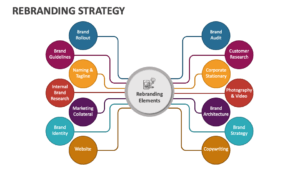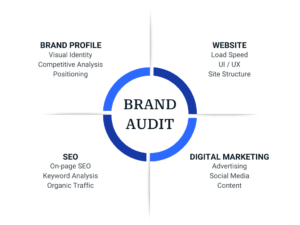Rebranding is a vital process that allows businesses to stay relevant, grow, and meet changing market demands. Whether you’re refreshing your company’s image or completely overhauling your business identity, a well-executed rebrand can strengthen your market position, build customer loyalty, and open doors to new opportunities. In this article, we’ll walk you through the ten essential steps to rebrand your business successfully.

Understanding the Rebranding Process
What is Rebranding?
Rebranding refers to the strategic process of changing a company’s image, identity, or overall market positioning. Businesses typically choose to rebrand for various reasons, such as adapting to market shifts, attracting new demographics, or responding to increased competition. Rebranding is an opportunity to breathe new life into a company, aligning its identity with evolving customer expectations, market trends, or internal transformations.
Why Do Businesses Rebrand?
There are several reasons why businesses embark on a rebranding journey:
- Market Shifts: As consumer behaviors and market conditions evolve, brands must adapt their messaging and design.
- Business Transformation: When a business undergoes significant changes, such as mergers, acquisitions, or diversification, rebranding helps communicate the new direction.
- Competitive Pressures: If competitors are outpacing your company, rebranding can differentiate your business and regain a competitive edge.
- Target Demographics: Changes in the demographic profile of your audience may require a new brand identity to better resonate with their preferences.
Rebranding involves a shift in visual elements, company values, or even a brand’s messaging to reflect these changes, ensuring alignment with the evolving market demands.
Conduct a Comprehensive Brand Audit

Why Is a Brand Audit Essential?
Before jumping into the rebranding process, it’s crucial to assess your current brand’s positioning, strengths, weaknesses, and how customers perceive your business. A brand audit serves as the foundation for an effective rebrand, as it identifies areas that need change and helps focus efforts on key business areas that require improvement.
Methods for Conducting a Brand Audit
- SWOT Analysis: Assess your company’s strengths, weaknesses, opportunities, and threats. This will help you understand both internal and external factors influencing your brand.
- Customer Feedback: Gather insights from surveys, interviews, or online reviews to understand your customers’ perceptions.
- Market Research: Analyze competitor brands and how your business stacks up in terms of product offerings, pricing, and positioning.
- Stakeholder Input: Engage with employees, partners, and other stakeholders to get a broader perspective on how your brand is viewed internally and externally.
Define Your New Brand Vision and Values

What Are the Key Elements of a New Brand Vision?
A successful rebrand should align with your business’s long-term mission, values, and vision. It’s essential to establish a clear direction for the future, one that resonates with both your employees and customers. This new vision will guide your brand messaging and help your business stand out in a competitive market.
Setting Clear Brand Goals
- Brand Mission: Clearly define what your brand aims to achieve. This includes your company’s purpose and the value it brings to customers.
- Core Values: These are the guiding principles that define how your company operates and connects with its customers.
- Brand Messaging: Ensure that all communications reflect your company’s new vision and values, aligning with your target audience’s needs and expectations.
By articulating a clear brand vision, you ensure that your rebranding efforts are consistent and aligned with your company’s objectives.
Refine Your Target Audience

Who Are Your New Target Customers?
Rebranding provides an excellent opportunity to reevaluate your target audience. Understanding and defining customer personas is critical to tailoring your rebrand effectively. Whether you’re targeting new demographics or refining your existing customer base, a precise audience analysis will guide your brand’s visual and verbal identity.
Customer Segmentation
- Demographic Analysis: Define the key characteristics of your audience, such as age, location, gender, income level, etc.
- Psychographics: Understand the lifestyle, values, interests, and behaviors of your target market.
- User Research: Conduct surveys and focus groups to understand consumer pain points and preferences.
By refining your target audience, you ensure that your rebranding efforts speak directly to the needs of your customers.
Create a New Brand Identity

Developing Visual and Verbal Identity
A strong brand identity is essential for creating recognition and differentiation in the market. This step involves revamping the visual elements of your brand, including your logo design, color scheme, typography, and overall brand aesthetics. The goal is to create a cohesive, appealing, and recognizable identity that resonates with your target audience.
Key Considerations for Brand Identity Development
- Logo Refresh: A redesigned logo can signify new beginnings, whether it’s a minor tweak or a complete overhaul.
- Color Psychology: Select colors that align with your brand’s message and evoke the desired emotional response.
- Typography: Choose fonts that reflect your brand’s personality and ensure readability across all mediums.
- Brand Guidelines: Develop a set of brand guidelines to ensure consistency in the use of visual assets across all touchpoints.
Your brand’s visual and verbal identity should communicate your redefined message clearly and memorably.
Develop a Strategic Marketing Plan

Crafting Your Marketing Strategy
To launch your new brand successfully, create a comprehensive marketing plan that encompasses all communication channels. This strategy will promote the new identity and build excitement among your customers.
Key Components of a Marketing Plan
- Digital Strategy: Utilize digital platforms like social media, email, and SEO to spread your brand message.
- PR Campaign: Craft a press release to announce the rebrand, reaching both media outlets and influencers.
- Launch Plan: Develop a timeline and detailed plan for rolling out your new brand identity across various channels.
- Content Strategy: Create engaging content (blogs, videos, infographics) that tells your brand’s story and communicates the change effectively.
A solid marketing strategy ensures a smooth transition, keeping customers informed and engaged throughout the process.
Engage with Customers Through Communication
Messaging Your Rebrand to Customers
Effective communication is key to ensuring your customers understand and embrace the changes. Use a variety of communication channels to reach your audience, including email campaigns, social media updates, and customer support.
Best Practices for Customer Communication
- Email Outreach: Inform your current customers about the rebrand through personalized email messages.
- Social Media Updates: Leverage social media to engage your audience with behind-the-scenes content, sneak peeks, and updates.
- Customer Support: Train your customer support team to address any questions or concerns related to the rebrand.
- Loyalty Programs: Use loyalty programs or incentives to retain existing customers during the rebrand transition.
By maintaining clear, open communication, you can increase customer trust and loyalty throughout the rebranding process.
Ensure Consistency Across All Platforms
Why is Brand Consistency Important?
Consistency across all customer touchpoints is crucial for reinforcing your new brand identity. Whether it’s on your website, social media, or in-person interactions, customers should experience a unified and cohesive brand message.
Key Areas to Focus On
- Omnichannel Strategy: Ensure your brand message is consistent whether customers interact with you online or in-store.
- Website Design: Update your website to reflect your new brand identity, ensuring consistency in colors, typography, and logo usage.
- Retail Experience: If you have physical stores, make sure the in-store experience aligns with your new brand identity.
Brand consistency fosters recognition, trust, and loyalty from your audience, making it a crucial aspect of the rebranding process.
Launch the Rebrand
Successfully Rolling Out Your New Brand
The rebrand launch is your opportunity to officially present your refreshed identity to the public. Plan the launch carefully to create excitement and generate buzz around your brand transformation.
Launching Your Rebrand
- Press Release: Issue a press release to announce your rebrand to the media and industry influencers.
- Social Media Campaign: Run a targeted campaign across social media platforms to reach a broad audience.
- Customer Engagement: Engage your current customers with special promotions, sneak peeks, or exclusive content related to the launch.
- Events: Consider hosting an online or in-person event to introduce your new brand identity.
A successful launch requires careful coordination to ensure that the rebrand is introduced with maximum impact.
FAQ: Rebranding Your Business
1. What is rebranding, and why should I consider it?
Rebranding involves changing your company’s image, which can include your logo, messaging, and overall market positioning. Businesses typically rebrand to adapt to market shifts, attract new customers, reflect internal changes, or stay competitive.
2. How do I know if my business needs a rebrand?
Signs that your business may need a rebrand include outdated branding, misalignment between your brand identity and company values, loss of market relevance, or failing to resonate with your target audience. A brand audit can help identify these issues.
3. What is the first step in the rebranding process?
The first step is conducting a comprehensive brand audit. This includes evaluating your brand’s strengths, weaknesses, and how it’s perceived by your target audience. It will help you understand where changes are needed and where your business stands in the market.
4. How do I define my new brand vision and values?
Your new brand vision and core values should align with your company’s mission and long-term goals. Engage with stakeholders, conduct market research, and ensure your vision resonates with both your internal team and target customers.
5. What is the role of customer feedback in rebranding?
Customer feedback is crucial during the rebranding process. It helps identify what resonates with your audience and what needs to change. Use surveys, interviews, and social media feedback to understand how your brand is perceived and where improvements can be made.
6. What elements should I focus on when creating a new brand identity?
When creating a new brand identity, focus on visual elements like your logo, color palette, and typography. Ensure that these elements reflect your new vision and appeal to your target audience. Equally important is developing a brand voice that communicates your core values effectively.
